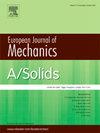Inverse modeling of heterogeneous ECM mechanical properties in nonlinear 3DTFM
IF 4.4
2区 工程技术
Q1 MECHANICS
引用次数: 0
Abstract
Accurate characterization of cellular tractions is crucial for understanding cell-extracellular matrix (ECM) mechanical interactions and their implications in pathology-related situations, yet their direct measurement in experimental setups remains challenging. Traction Force Microscopy (TFM) has emerged as a key methodology to reconstruct traction fields from displacement data obtained via microscopic imaging techniques. While traditional TFM methods assume homogeneous and static ECM properties, the dynamic nature of the ECM through processes such as enzyme–induced collagen degradation or cell-mediated collagen deposition i.e. ECM remodeling, requires approaches that account for spatio-temporal evolution of ECM stiffness heterogeneity and other mechanical properties. In this context, we present a novel inverse methodology for 3DTFM, capable of reconstructing spatially heterogeneous distributions of the ECM’s stiffness. Our approach formulates the problem as a PDE-constrained inverse method which searches for both displacement and the stiffness map featured in the selected constitutive law. The elaborated numerical algorithm is integrated then into an iterative Newton–Raphson/Finite Element Method (NR/FEM) framework, bypassing the need for external iterative solvers. We validate our methodology using in silico 3DTFM cases based on real cell geometries, modeled within a nonlinear hyperelastic framework suitable for collagen hydrogels. The performance of our approach is evaluated across different noise levels, and compared versus the commonly used iterative L-BFGS algorithm. Besides the novelty of our formulation, we demonstrate the efficacy of our approach both in terms of accuracy and CPU time efficiency.
非线性3DTFM中异质ECM力学性能的逆建模
细胞牵引力的准确表征对于理解细胞-细胞外基质(ECM)的机械相互作用及其在病理相关情况下的意义至关重要,但它们在实验装置中的直接测量仍然具有挑战性。牵引力显微镜(TFM)已经成为通过显微成像技术获得的位移数据重建牵引力场的关键方法。虽然传统的TFM方法假设ECM具有均匀和静态的特性,但通过酶诱导的胶原降解或细胞介导的胶原沉积(即ECM重塑)等过程的ECM动态特性需要考虑ECM刚度异质性和其他力学特性的时空演变。在这种情况下,我们提出了一种新的3DTFM反演方法,能够重建ECM刚度的空间非均匀分布。我们的方法将问题表述为pde约束的逆方法,该方法同时搜索所选本构律中的位移和刚度映射。然后将精心设计的数值算法集成到迭代牛顿-拉夫森/有限元法(NR/FEM)框架中,绕过了外部迭代求解器的需要。我们使用基于真实细胞几何形状的硅三维tfm案例验证了我们的方法,该案例在适合胶原蛋白水凝胶的非线性超弹性框架内建模。我们的方法在不同的噪声水平下进行了性能评估,并与常用的迭代L-BFGS算法进行了比较。除了我们的公式的新颖性之外,我们还证明了我们的方法在准确性和CPU时间效率方面的有效性。
本文章由计算机程序翻译,如有差异,请以英文原文为准。
求助全文
约1分钟内获得全文
求助全文
来源期刊
CiteScore
7.00
自引率
7.30%
发文量
275
审稿时长
48 days
期刊介绍:
The European Journal of Mechanics endash; A/Solids continues to publish articles in English in all areas of Solid Mechanics from the physical and mathematical basis to materials engineering, technological applications and methods of modern computational mechanics, both pure and applied research.

 求助内容:
求助内容: 应助结果提醒方式:
应助结果提醒方式:


